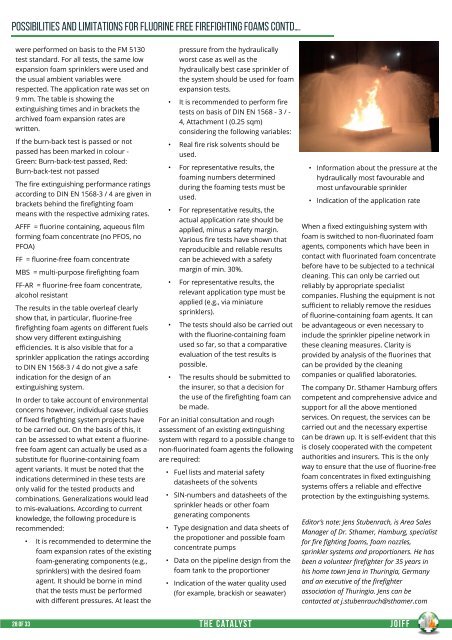The CATALYST_October_2017
You also want an ePaper? Increase the reach of your titles
YUMPU automatically turns print PDFs into web optimized ePapers that Google loves.
Possibilities and Limitations for Fluorine Free Firefighting Foams contd….<br />
were performed on basis to the FM 5130<br />
test standard. For all tests, the same low<br />
expansion foam sprinklers were used and<br />
the usual ambient variables were<br />
respected. <strong>The</strong> application rate was set on<br />
9 mm. <strong>The</strong> table is showing the<br />
extinguishing times and in brackets the<br />
archived foam expansion rates are<br />
written.<br />
If the burn-back test is passed or not<br />
passed has been marked in colour -<br />
Green: Burn-back-test passed, Red:<br />
Burn-back-test not passed<br />
<strong>The</strong> fire extinguishing performance ratings<br />
according to DIN EN 1568-3 / 4 are given in<br />
brackets behind the firefighting foam<br />
means with the respective admixing rates.<br />
AFFF = fluorine containing, aqueous film<br />
forming foam concentrate (no PFOS, no<br />
PFOA)<br />
FF = fluorine-free foam concentrate<br />
MBS = multi-purpose firefighting foam<br />
FF-AR = fluorine-free foam concentrate,<br />
alcohol resistant<br />
<strong>The</strong> results in the table overleaf clearly<br />
show that, in particular, fluorine-free<br />
firefighting foam agents on different fuels<br />
show very different extinguishing<br />
efficiencies. It is also visible that for a<br />
sprinkler application the ratings according<br />
to DIN EN 1568-3 / 4 do not give a safe<br />
indication for the design of an<br />
extinguishing system.<br />
In order to take account of environmental<br />
concerns however, individual case studies<br />
of fixed firefighting system projects have<br />
to be carried out. On the basis of this, it<br />
can be assessed to what extent a fluorinefree<br />
foam agent can actually be used as a<br />
substitute for fluorine-containing foam<br />
agent variants. It must be noted that the<br />
indications determined in these tests are<br />
only valid for the tested products and<br />
combinations. Generalizations would lead<br />
to mis-evaluations. According to current<br />
knowledge, the following procedure is<br />
recommended:<br />
• It is recommended to determine the<br />
foam expansion rates of the existing<br />
foam-generating components (e.g.,<br />
sprinklers) with the desired foam<br />
agent. It should be borne in mind<br />
that the tests must be performed<br />
with different pressures. At least the<br />
pressure from the hydraulically<br />
worst case as well as the<br />
hydraulically best case sprinkler of<br />
the system should be used for foam<br />
expansion tests.<br />
• It is recommended to perform fire<br />
tests on basis of DIN EN 1568 - 3 / -<br />
4, Attachment I (0.25 sqm)<br />
considering the following variables:<br />
• Real fire risk solvents should be<br />
used.<br />
• For representative results, the<br />
foaming numbers determined<br />
during the foaming tests must be<br />
used.<br />
• For representative results, the<br />
actual application rate should be<br />
applied, minus a safety margin.<br />
Various fire tests have shown that<br />
reproducible and reliable results<br />
can be achieved with a safety<br />
margin of min. 30%.<br />
• For representative results, the<br />
relevant application type must be<br />
applied (e.g., via miniature<br />
sprinklers).<br />
• <strong>The</strong> tests should also be carried out<br />
with the fluorine-containing foam<br />
used so far, so that a comparative<br />
evaluation of the test results is<br />
possible.<br />
• <strong>The</strong> results should be submitted to<br />
the insurer, so that a decision for<br />
the use of the firefighting foam can<br />
be made.<br />
For an initial consultation and rough<br />
assessment of an existing extinguishing<br />
system with regard to a possible change to<br />
non-fluorinated foam agents the following<br />
are required:<br />
• Fuel lists and material safety<br />
datasheets of the solvents<br />
• SIN-numbers and datasheets of the<br />
sprinkler heads or other foam<br />
generating components<br />
• Type designation and data sheets of<br />
the propotioner and possible foam<br />
concentrate pumps<br />
• Data on the pipeline design from the<br />
foam tank to the proportioner<br />
• Indication of the water quality used<br />
(for example, brackish or seawater)<br />
• Information about the pressure at the<br />
hydraulically most favourable and<br />
most unfavourable sprinkler<br />
• Indication of the application rate<br />
When a fixed extinguishing system with<br />
foam is switched to non-fluorinated foam<br />
agents, components which have been in<br />
contact with fluorinated foam concentrate<br />
before have to be subjected to a technical<br />
cleaning. This can only be carried out<br />
reliably by appropriate specialist<br />
companies. Flushing the equipment is not<br />
sufficient to reliably remove the residues<br />
of fluorine-containing foam agents. It can<br />
be advantageous or even necessary to<br />
include the sprinkler pipeline network in<br />
these cleaning measures. Clarity is<br />
provided by analysis of the fluorines that<br />
can be provided by the cleaning<br />
companies or qualified laboratories.<br />
<strong>The</strong> company Dr. Sthamer Hamburg offers<br />
competent and comprehensive advice and<br />
support for all the above mentioned<br />
services. On request, the services can be<br />
carried out and the necessary expertise<br />
can be drawn up. It is self-evident that this<br />
is closely cooperated with the competent<br />
authorities and insurers. This is the only<br />
way to ensure that the use of fluorine-free<br />
foam concentrates in fixed extinguishing<br />
systems offers a reliable and effective<br />
protection by the extinguishing systems.<br />
Editor’s note: Jens Stubenrach, is Area Sales<br />
Manager of Dr. Sthamer, Hamburg, specialist<br />
for fire fighting foams, foam nozzles,<br />
sprinkler systems and proportioners. He has<br />
been a volunteer firefighter for 35 years in<br />
his home town Jena in Thuringia, Germany<br />
and an executive of the firefighter<br />
association of Thuringia. Jens can be<br />
contacted at j.stubenrauch@sthamer.com<br />
28 of 33 <strong>The</strong> Catalyst JOIFF

















